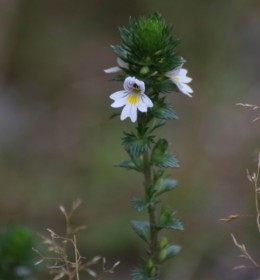As the name rightly suggests, eyebright is a herb that has been used as a herbal remedy for eye problems, through the centuries. This article provides some information about the herb and its uses.

Eyebright belongs to the plant family
Orobanchaceae and the genus
Euphrasia, which consists of around 450 species of semi-parasitic flowering plants. These plants are commonly known as eyebright herb, due to their use in treating eye infections. Even though, there are many species in the genus
Euphrasia,
Euphrasia officinalis is considered the original eyebright herb. It is also known as
Euphrasia rostkoviana.
This plant is commonly found in different parts of the eastern European countries, like Yugoslavia and Hungary. It is believed that, this herb has been used by humans since the Stone Age. Eyebright is a popular and important herb that has been used for treating eye problems.
The Plant
This plant is semi-parasitic, as its roots get attached to the roots of grass, for food. Eyebright is a small plant with a height that ranges between two to eight inches. It has serrated, lance-shaped leaves, and erect stems that end in flowers. Flowering occurs between July to September. The flowers are small and white, with purple stripes and yellow patches. These flowers produce seeds in flat, ribbed capsules, that are very small. The whole plant, except the roots are used for making eyebright herb powder, extract, tincture, lotion, and tea. Harvesting is done between July and August, which is the blooming season for this plant. The herb is said to be the most effective, when harvested during this period. The plant is cut just above the roots.
Health Benefits
Eyebright acts as an anti-inflammatory agent and as an astringent. It has been used to treat inflammatory eye disorders, like conjunctivitis (pink eye), blepharitis, dry eye, and eye stye. Eyebright is used in the form of poultice, so as to reduce the swelling and other symptoms associated with these eye conditions. The affected person may also be administered with eyebright tea, for fast healing.
The herb is also used for relief from eye strain; and for treating health problems, like cold, sinus infections, hoarse throat, and cough. In some regions, eyebright is used for treating allergies, bronchitis, and other upper respiratory problems. Eyebright is also used to prepare an eyewash, that is also used to relieve swelling and irritation of the eyes. Even though, there is no scientific evidence to prove the effectiveness of eyebright in treating these eye problems; it is claimed that, this herb contains tannins, that can reduce irritation, promote tissue firmness and reduce mucus secretion. It is also contended that, this herb has antibacterial properties.
Even though, eyebright is claimed to be one of the most effective herbs for treating some eye problems, it is not completely free of side effects. If taken orally, this herb may cause side effects, like nausea, sweating and confusion. Eyewash and poultice made with this herb may also cause side effects, like photo sensitivity, itching, inflammation of the eyelids, changes in eye pressure, and vision problems. In case of such side effects, you should stop using the herb and contact an eye specialist at the earliest. This herb should not be used by pregnant and nursing women, kids, people who wear contact lenses, and those who have undergone eye surgery. So if you want to try eyebright, approach a qualified herbal practitioner and follow his instructions. Eyebright is not approved by the FDA, as a herbal medicine and so, there are apprehensions regarding its use.
Disclaimer:
This article is for informational purposes only, and should not be used as a replacement for expert medical advice.






 Eyebright belongs to the plant family Orobanchaceae and the genus Euphrasia, which consists of around 450 species of semi-parasitic flowering plants. These plants are commonly known as eyebright herb, due to their use in treating eye infections. Even though, there are many species in the genus Euphrasia, Euphrasia officinalis is considered the original eyebright herb. It is also known as Euphrasia rostkoviana.
Eyebright belongs to the plant family Orobanchaceae and the genus Euphrasia, which consists of around 450 species of semi-parasitic flowering plants. These plants are commonly known as eyebright herb, due to their use in treating eye infections. Even though, there are many species in the genus Euphrasia, Euphrasia officinalis is considered the original eyebright herb. It is also known as Euphrasia rostkoviana.